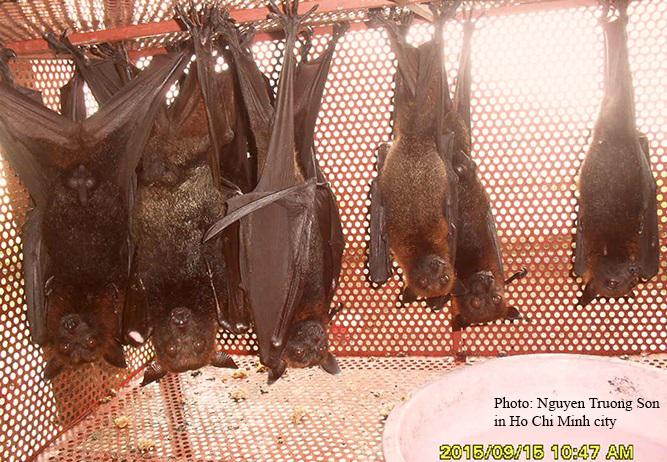Tu Vuong Tan
Other projects
18 Jan 2012
A Program for Conservation of Biodiversity and Endemism of Bats in Scattered Forests and Cave Complex in North Western, Vietnam
The project aims to conduct several comprehensive investigations to assess the impacts of human activities on species richness, phylogenetic and phylogeographic patterns of bat assemblages and their related pathogens (viruses and malaria parasites) in urban areas.

Large Flying-fox, Pteropus vampyrus, (weight up to 1kg), was illegally and sold as bushmeat.
Over recent decades, coupled with fast economic growth, Vietnam has undergone a human population boom and rapid urbanization. Associated with these processes, land use changes and growing exploitation of natural resources have led to a dramatic reduction in native biodiversity; this consequently imposes constraints on the country’s sustainable development. This conservation concern is especially notable in urban areas, which support roughly 35 million people (>30% of national population). Although having poor quality habitats, urban and surrounding areas retain capacity to support numerous native species. Bats provide many ecological and economic services, but little is known about their current status and ecological requirements in Vietnam. Because several bat species worldwide are known to be natural reservoir hosts for zoonotic pathogens including human pathogenic coronaviruses (SARS Coronavirus), hendraviruses (Henipa, Nipah), and Ebola viruses, close contact between humans, livestock and bats in urban areas may increase emergence risk of bat-borne infectious diseases. To date, scientific knowledge and social awareness of public health risks from bat pathogens in Vietnam remain neglected. Thus, this proposed project aims to address the above issues and thereby strengthen bat conservation and public health protection in Vietnam, and by inference elsewhere in southeast Asia. More specifically, we will quantify:
(1) the species richness, abundance, and benefits of bat assemblages in urban and surrounding areas in different regions of Vietnam;
(2) infection patterns and evolutionary processes of bat-related zoonotic pathogens (viruses and malaria parasites, many of which are now likely un-described or unknown for Vietnam);
(3) ecological factors driving the current community structure and cross- species spillovers of detected bat-related pathogens.
Results of these investigations will be made available to the general public by releasing scientific papers/reports, articles in mainstream media, awareness-raising materials, and training programs for developing appropriate conservation measures. These educational materials will highlight the negative impacts of human changes to local environments on bats and other wildlife, as well as the potential risks of cross-species spillover of zoonotic diseases. New knowledge-based information will thereby strengthen conservation actions that can ensure environmental sustainability while maintaining human well-being.